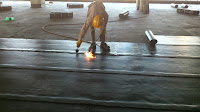Waterproofing :
Waterproofing concrete is important to protect the surface from excessive moisture. When water seeps into concrete, the concrete expands and contracts due to cycles of freezing and thawing. Cracks and holes may form as a result. Waterproofing will help protect against this problem. Waterproofing sealant cannot be applied to concrete that has not been properly prepared. Preparing concrete for waterproofing is an important step in ensuring that the waterproofing sealer works properly.
Instruction(Preparation for waterproofing):
-
Allow new concrete to cure for a minimum of seven days before waterproofing. Repair any damaged areas of the concrete. Fill in cracks or holes with a concrete patching compound.
- Scrub the concrete with a dry, stiff brush to loosen any lodged dirt or debris. Follow up by sweeping the concrete with a broom. If you're waterproofing concrete walls, use the soft brush attachment on a vacuum cleaner rather than a broom.
- Simple way , with the help of chipping hammer remove spawl or spall i.e ( However, all concrete construction has one problem in common. A flaking, crumbling part of the surface, called a spawl or spall, is an early warning sign that concrete repairs are required. Repair a concrete spawl immediately to minimize the extent and expense of the work.) than a thin plaster (2-4mm) is needed for closing small holes and making surface smooth as shown in pic 1 and 2. This method I used in Novotel and Ibis Hotel.
Using DPC ( Damp Proof Course ) for waterproofing :
1) Waterproof, dampproof, ageing-resistant, leakproof
2) No flowing at highest temperature and no crack at
2) No flowing at highest temperature and no crack at
A damp proof course ( DPC ) is a physical barrier inserted into the fabric of a building to stop water passing from one place to another.
This can be on a horizontal plane, stopping water rising up from the ground by being sucked up by the dry masonry above, or vertically to stop water passing from the outside of a building, though the masonry, to the inside.
DPC's have taken many forms through the ages and one of the earliest forms was to use a layer of slate in the construction.
Slate is still used but the less expensive plastic version ( below right ) is now more widely used.
Benefits of DPC :
- Fully Inert & Unaffected by LOSP Timber treatments
- High Strength
- Extreme Durability












